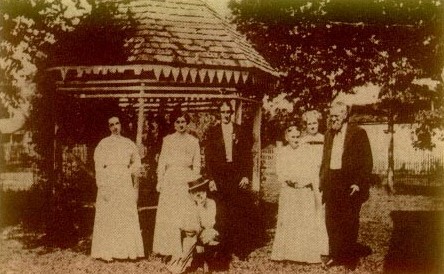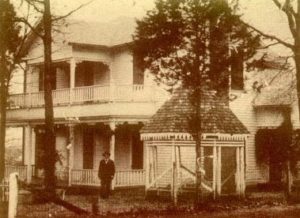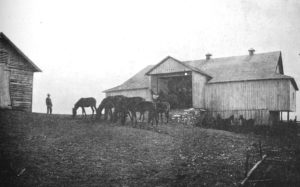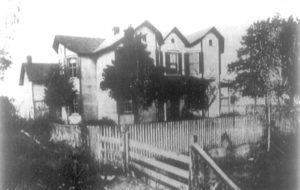
- Pictured in front of a gazebo is (left to right) Miss Mary Hertzler, Mrs. Shelby Lanier nee Bradford, Daniel Hertzler, an unidentified person, Dr. John Hertzler and kneeling is Gordon Anderson. Photo courtesy of John Rankin
Sent from Pennsylvania to help others ravaged by war in the south, Dr. John Huber Hertzler became known as “The Sage of Mullens Flat”

- The Hertzler Home (now torn down) on the corner of College Street and Church Street. Photo courtesy of John Rankin
By John P. Rankin, Madison historian
MADISON – After the Civil War, John Hertzler’s father sent him south from Pennsylvania to help those suffering from the ravages of war. His journey would land him in Madison where he became a prominent doctor, where he became known as “The Sage of Mullens Flat”.
The 1975 family book “Jacob Hertzler and his Descendants” by Katharine D. Anderson (a Hertzler descendant) tells that Madison’s Dr. John Huber Hertzler was a son of Jacob Hertzler and Fannie Huber. John married Annie Garber, whose parents were Anna Nissley and Andrew Garber. Anna Nissley’s parents were John Nissley and Anna Hershey, a daughter of Christian Hershey of Pennsylvania.
John Hertzler was born in 1828, West Hempfield township, Lancaster County, Pennsylvania. He and Anna Garber were married in Pennsylvania in 1851. Sometime between 1853 and 1856 they moved to Clark County, Ohio, where the last six of their seven children were born.
The 1860 census showed John’s occupation as “Car. (Carpenter?) on Saw Mill”. The Hertzler family book says that he was a captain in the Union army during the Civil War. It further adds that after the war, his father, Jacob, provided $60,000 to John for him to go to the South in order to do “missionary type work, helping the people who had suffered such a loss during the war.”
It is unknown whether helping the people of the South was truly John Hertzler’s intent in moving his family from Ohio to Madison County, Alabama, around 1869. However, that is what he accomplished.
Hertzler settled his family initially about five miles from the village of Madison, on land that is now part of Redstone Arsenal. There he built a farmhouse and barn that became models of innovation in the area. He had another impressive “town” house built in Madison, in the southwestern corner of the junction of Church Street with College Street.
Hertzler incorporated the use of elevated metal tanks to catch rainwater from gutters, allowing for gravity-fed running water distribution in the houses, more convenient than hand pumping or drawing water buckets from the commonly used cisterns in the ground.
His barn on the farm was noted for incorporation of loading ramps that allowed hay to simply be rolled down into the loft rather than needing a hoist to lift it to the top of a stack from the ground level. Some of his techniques were described in newspapers of the day and in such forums as the booklet “Huntsville and Madison County, Alabama” published in 1908 by The Business Men’s League of Huntsville.
Additionally, somewhere along the line, John Hertzler became a medical doctor. He was listed as a physician in “Polk’s Medical Register and Directory of North America” in 1902 and 1904. His death certificate and the newspaper obituaries at the time of his passing noted that he was a physician, as did the transactions of the Medical Association of Alabama in 1900. There he was shown as having received his training and education in homeopathic medicine at the University of Nashville. Still, John Jr. died of tuberculosis at the age of 49 in 1913, since his father’s medicines of the day could not cure it.
The Hertzler family book includes recollections of a black man who told of being treated by “old Doc Hertzler”. In those days, often the doctor was paid in “trade” by bringing a chicken or eggs that could be spared when no money was available.
Dr. Hertzler’s grandson, Harvey Gordon Anderson, as a child is mentioned in the family book as having often complained to his grandfather that he did not feel well, so that he would be given a bottle of sugar pills.
The Hertzler book further mentioned that Dr. John wrote articles for the Weekly Mercury, a Huntsville newspaper of the time. Unfortunately, no by-lines providing credits were used in the newspapers then. However, the family book went on to mention that Dr. Hertzler became known as “The Sage of Mullens Flat” because of those articles.
That lends credibility to the family tradition, since Mullens Flat was an area of today’s Redstone Arsenal near where Hertzler lived on his farm property. He may well have been writing to provide helpful and healthful information to farmers of the area. Therefore, it can indeed be assumed that Dr. Hertzler helped the people of the South to recover in many ways from the devastation of the Civil War.
Dr. John Hertzler was not only an innovator for the South after the war, he also hosted guests from the north who could likewise expose Southerners to more ideas from the old Union territories.
In the late 1800s people could visit distant relatives by train with an ease and frequency that had previously been impossible. The railroads brought the country together. An example is seen in the 1877 diary of Henry B. Reist of Lancaster County, Pennsylvania, when a party of six visited their Hertzler relatives in Madison, as excerpted with minimum paraphrasing in the following paragraphs.
Departing Lancaster County on October 17, Henry and his wife, accompanied by John Nissley and wife plus Henry Snavely and wife, traveled from Pennsylvania for visits in Ohio, Missouri, Kansas, Indiana, Tennessee, Alabama, Virginia, and Washington, D.C. The description of their visit here is described in the Reist diary as follows:
November 5, Sunday afternoon, Decatur, Alabama: Had to lay over here for the morning train to Madison. Arrived in Madison (November 6) and got a man with a team to take us to Hertzlers (arsenal land location), where we arrived about 11 a. m. It rained all morning, but nearly quit as we drove out. We found them all well and at home engaged in ginning cotton. Letters from home were awaiting us at this place.
November 7: This evening we were down to the creek (Indian Creek, where it runs through the arsenal) to see the beaver dam. It was about two miles, one mile through dense forest. It was after 3 o’clock when we started. We stopped on the way to shoot at a flock of pigeons, without getting any. We found the dam about three feet high, made of leaves with logs and sticks. The dam was at least 125 feet long. The beavers cut down trees up to 12 inches in diameter and float them down the stream to the dam. The kind of timber at the Hertzlers includes sour wood, dogwood, water oak, white oak, post oak, span oak, red oak, walnut, sweet gum, Cupalo (Tupelo) gum, black gum, red elm, white elm, shell-bark hickory, white and red chestnut, sassafras, ash, birch, sycamore, beech, persimmon, and paw-paw.
November 9: We are still here enjoying the hospitality of the Hertzlers in the true Southern Planter’s style. Passing our time rambling over the farm, through the woods and swamp. They have very fine timber, with trees four and five feet in diameter. I never met with such fine splitting wood. Yesterday we went after ducks and got a rabbit and four quail in the afternoon. Frank Hertzler shot a wild goose.
Saturday, November 10: Today we have been to Huntsville in company with Mr. Hertzler, distance ten miles. On our way in, we called at the homes of McCullough, Wells, and Zell. We then went to the McGee house and got dinner (“lunch” today). Then went to see the big spring, which is right in town under the houses. It is as large as Big Chicques Creek. We then went to the post office and got letters from home dated November 3. We then went to Mr. McCommough’s office, which is in the Calhoun House, a private residence rented by the United States as a U. S. Marshall’s office and district courthouse for northern Alabama. The frescoeing of the building was done by an artist brought from Paris. We then started for home, where we arrived safely at 8:30 p.m.
Sunday morning, November 11: This morning at John Hertzler’s house we had quite a sharp frost, the thermometer standing at 32 degrees. This is the finest sunny morning yet since we came to Alabama.
Sunday evening: Today we were at Mr. Lanier’s. They are “dyed in the wool” secessionists, as they called them. He had before the war over 100 slaves and 3,000 acres. At present he has about 1,700 acres. We took dinner with them, which consisted of soup first, then cabbage and bacon, cornbread, roast turkey, potatoes, and yams. For dessert we had sweet potatoes or grange pudding with milk to drink. These Southern men seem friendly; I would not be afraid to live among them.
The visitors left on the 9 a.m. Monday morning train from Madison for Washington, D. C., no doubt with a new perspective on the ambiance of life in the South. From the details in the diary, it can be deduced that the visitors did not stay in the Hertzler house in Madison for most of their stay. Rather, they apparently headquartered in the Hertzler farmhouse, as depicted in the 1908 book of the Business Men’s League of Huntsville, Alabama. They may have even inspected the Hertzler barn on what became Redstone Arsenal land, but to them it would not have been unusual.
The Hertzler barn on the arsenal land was constructed on a slope that enabled hay to be entered at the upper level. When the hay was needed later, it could be simply pushed or rolled and dropped down to the lower level ground entrance for hauling to the point of need in a wagon. The roof vents lessened the chance of combustion as the hay dried and preserved its nutritional quality for livestock.

- The Hertzler Barn in 1908. Note the use of roof vents. The roof vents lessened the chance of combustion as the hay dried and preserved its nutritional quality for livestock. This photo also appeared in the Business Men’s League publication of 1908, found in the Heritage Room of the Huntsville – Madison County Public Library. Photo courtesy of John Rankin







